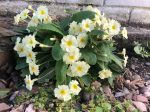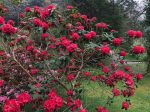By now I think I can tentatively say both my hives – Kensa and Nessa – have survived winter. Over the past couple of weeks my priority has changed from getting the bees through the cold months to being on the alert for swarming!
On Tuesday I popped down to try to check inside the hives and sort a few things out. But the Cornish weather just wasn’t playing ball. The sun would come out while I was getting my smoker going, only for a downpour of hailstones just as I was trying to inspect. The belligerent rain defeated me and I retreated inside with only my Kensa hive peeked at. At least I managed to quickly confirm that Kensa is laying and both colonies have begun to draw out the supers of foundation I put on at the weekend.
We did have some sunshine for Mothers Day luckily. Drew took Tommy and I to Glendurgan Gardens in Cornwall. As Drew ran energetically round the maze there with an ecstatic Tommy bouncing on his shoulders, I had a look at a spectacular bank of wildflowers and was rewarded by an unexpected sight. A large hole had been dug in the surface of the bank and the occupant was coming slowly out. At first I couldn’t work out if I was seeing its front or back – the creature looked almost like a tiny black mole with a wiggling blue nose. Then its face emerged and I realised I was looking at a rather pretty large black beetle with a blue sheen to its front legs. I took a video and uploaded it to YouTube: Black Oil beetle at Glendurgan gardens, Cornwall
Back at home, I joined a Facebook group for British beetles (or for people into British beetles, I expect beetles have better things to do than go on Facebook). Some kind people on this group quickly identified it as a oil beetle, which they explained rely on solitary mining bees to complete their life cycles. The beetle I saw was a female Black oil beetle laying her eggs. After her larvae hatch they will climb up a suitable flower and jump on a solitary bee, riding back to its nest.
Once inside the bee’s nest, the larva disembarks and begins to feed on the bee’s eggs and her carefully gathered store of pollen and nectar. The larva develops in the bee burrow until it emerges as an adult oil beetle ready to mate and start the whole cycle again. Like solitary bees, these rather special sneaky beetles are becoming rarer in the UK due to loss of their habitat.
Having enough wildflowers is so important for our wildlife. The charity Buglife have an information sheet on oil beetles which says that the adult black oil beetles prefer Lesser celandine and soft grasses as food plants, but Dandelion and Buttercups may also be important.
Here are a few photos I’ve taken over the last couple of weeks of the flowers around Cornwall:
- Forget-me-nots
- Pink primroses
- Yellow primroses
- Spanish bluebell
- Violets
- Rhododendron at Glendurgan gardens
Spanish bluebells and forget-me-nots have now turned my garden blue. Our pale pink cherry tree has come out and our two mini apple trees have dark pink buds. Lots of dandelions, still a profusion of primroses – I don’t remember seeing so many primroses anywhere else I’ve lived before Cornwall. I love seeing all the different flowers coming out as the year goes on. This week I bought some sunflower and borage seeds – to plant when the rain stops!







So interesting to read about the oil beetle!
LikeLike
I was fascinated to read about them too! A sign of a good solitary bee population at Glendurgan.
LikeLike
It’s a fascinating video. We do get oil beetles in south Devon along the coast but I haven’t seen any this year so far. A week or so ago, however, I did see a mating pair of bloody nosed beetles!
LikeLike
Fantastic! Happy beetle spotting. Apparently the South West is a stronghold for the oil beetles.
LikeLike
Great video! Your garden sounds great for the bees. It must be so lovely for you seeing them every day instead of having to go to the apiary. Amelia
LikeLike
Actually the bees are not in my garden but at my in-laws house as that is where the swarm headed by Kensa arrived last year! Which was part of why I was inspecting under sub-optimal conditions, I have to fit in inspections around work and Tommy entertaining. But it’s only about a 15 minute drive to the bees now that I’ve passed my driving test.
LikeLiked by 1 person
I hope the in-laws enjoying watching the bees too.
LikeLike
I am glad both your colonies made it through the winter. I really enjoyed the flower pictures.
LikeLike
Thanks, glad you liked them!
LikeLike
Now, wouldn’t that be something-beetles with their own FB page. I’d sign up for that!
LikeLike
Beetles would have great FB discussions!
LikeLiked by 1 person
Very interesting post about the oil beetles. I have not heard of them before, and will look out for them here in Sussex.
But its a definite thumbs down to Spanish bluebells. As I understand it they are a threat to our native bluebell woods through hybridisation. I dig them up and destroy them when I can. The native bluebells where I keep my bees are a sight to behold and are just starting to flower now.
Why not try growing some native bluebells in your garden? If you have the patience you can even grow them from seed though it may take a while for them to reach flowering size. If you cannot find seed I could send you some (in July).
LikeLike
Hope you get to spot some oil beetles. I’ll have a look around some of the bee friendly plant suppliers I use to see if I can find any native bluebells for sale.
LikeLike